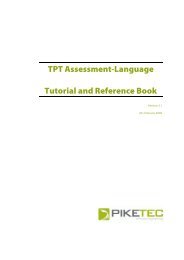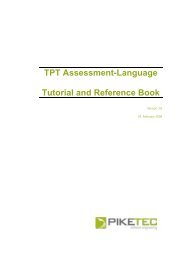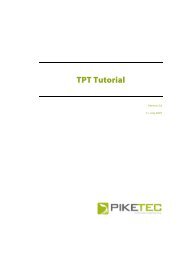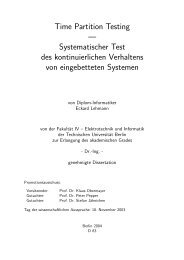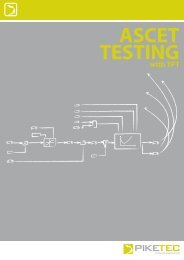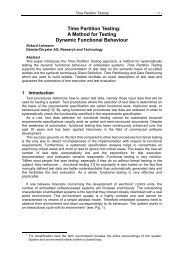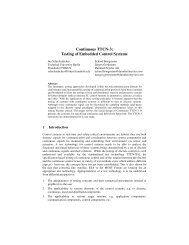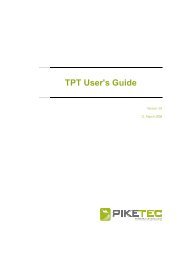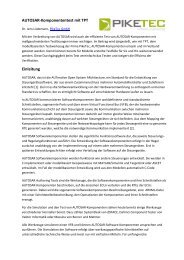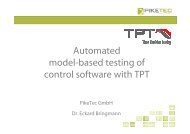TPT User's Guide - PikeTec
TPT User's Guide - PikeTec
TPT User's Guide - PikeTec
You also want an ePaper? Increase the reach of your titles
YUMPU automatically turns print PDFs into web optimized ePapers that Google loves.
<strong>TPT</strong> <strong>User's</strong> <strong>Guide</strong> Page 27<br />
5.2 Defining Equations<br />
add channel<br />
Definition equation<br />
Signal editor window<br />
Figure 14: Modelling by means of "direct definitions"<br />
Before the equations of a testlet of type “direct definition” can be entered, at least one scenario<br />
must be associated with the testlet. If no scenario is defined for the testlet, please create one<br />
(see Definition of Scenarios). Additionally, the signature of the testlet should contain at least<br />
one stimulation channel or local channel (see section 133: Signature of a Testlet).<br />
To enter the equations of a scenario, select the scenario in the scenario browser. The “content”<br />
tab will then display the table of equations for that scenario (see section 5: Modelling a Testlet<br />
by “Direct Definition”).<br />
Signals, which you want to assign to a channel, can also be modelled with the signal editor (see Defining<br />
signals).<br />
A function wizard exists to aid the channel definitions (cf. section 13).<br />
When entering an expression, Ctrl+Space opens a popup that lists all channels that are available to<br />
the expression. Using the Enter key on a channel will import it into the expression at the current cursor<br />
position.<br />
5.3 Changing the order of definition equations<br />
The equations are evaluated in from top to bottom, thus the order is relevant. They may be<br />
moved by drag and drop the channel to the new position. (see Figure 14).<br />
In former versions of <strong>TPT</strong> it was possible to change the order of definition equations within the testlet for<br />
every scenario individually. This is not possible anymore in the release 3.1 and may change the semantics<br />
of former versions of <strong>TPT</strong>-files. These direct definitions must be checked manually in order to avoid<br />
unexpected behavior when executing earlier versions of <strong>TPT</strong>-files with <strong>TPT</strong> 3.1 and higher.



